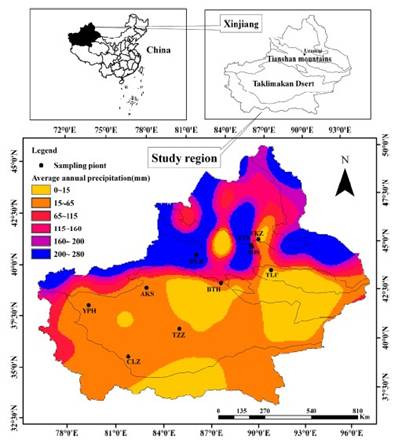Atmospheric Reactive Nitrogen Concentrations in Different Ecosystems in Arid Region
2012-11-28
With a consequent increase in atmospheric deposition of Nr species, anthropogenic activities have greatly accelerated the emissions of reactive nitrogen (Nr) species worldwide. Elevated N deposition/addition may lead to declining biodiversity and increasing N2O emission. So Nr deposition has become an important public concern in the academic studies.
In arid region, N limitation of plant growth often occurs. Rapid economic development and N fertilizer application have led to significant N deposition in this region. Atmospheric Nr deposition can increase atmospheric Nr pollution, but they may also act as an important source of plant nutrients. Thus, N inputs from Nr deposition can have an important N fertilizer effect in arid regions. However, very little is known about the influence of air pollutants and the dynamics of Nr concentrations in arid region.
To determine the spatial and seasonal characteristics of atmospheric Nr concentrations in different ecosystems within the arid region of northwest China, Dr. LI Kaihui et al. selected ten sites in Xinjiang respectively.
By statistical analysis, they found that concentrations of NH3, NO2, particulate ammonium and nitrate (pNH+4 and pNO−3) showed large spatial and seasonal variation and averaged 7.71, 9.68, 1.81 and 1.13 µgNm−3, respectively. While PM10 concentrations showed anaverage of 249.2 µgm−3 in all sites. In this study, lower NH3 concentrations and higher NO2, pNH+4 and pNO−3 concentrations were found in winter, reflecting serious air pollution in the study area. The increasing order of total concentrations of Nr species was alpine grassland, desert and desert-oasis ecotone, desert in an oasis, farmland, suburban and urban ecosystems. Their results indicated that the ratios of secondary particles (NH+4 and NO−3) were low in the desert and desert-oasis ecotone, but high in the urban and suburban areas. The findings implied that anthropogenic activities have greatly influenced the local air quality. So, effective controlling measures should be taken to control the air pollution.
The result has been published on Biogeosciences, 2012, 9: 4013–4021. The paper can be downloaded from http://www.doaj.org/doaj?func=abstract&id=1096097.

Distribution of the ten monitoring sites in Xinjiang (Image by XIEG)



